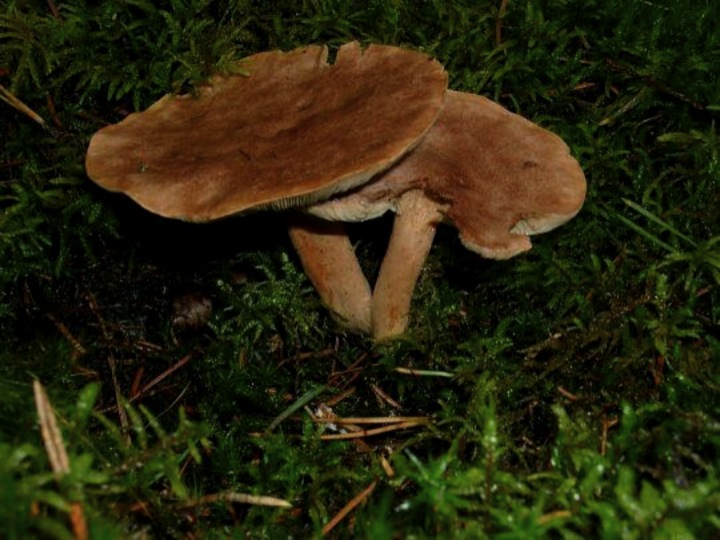Lactarius helvus, the maple syrup milky cap
 Lactarius helvus is a milky cap of the family Russulaceae, and occurs widely throughout North America and also Europe. It generally grows in boggy, mossy areas and is probably mycorrhizal with coniferous trees. It has some easily identifiable characteristics. This milky cap releases a watery and colorless latex that does not stain the flesh of the mushroom. The whole mushroom has a distinct scent reminiscent of curry or maple syrup. Although this odor is sometimes weak in young specimens it becomes more pungent upon drying. Is it toxic? Some authors report this mushroom in North America to be mildly poisonous while others claim that it is edible (but see below!).
Lactarius helvus is a milky cap of the family Russulaceae, and occurs widely throughout North America and also Europe. It generally grows in boggy, mossy areas and is probably mycorrhizal with coniferous trees. It has some easily identifiable characteristics. This milky cap releases a watery and colorless latex that does not stain the flesh of the mushroom. The whole mushroom has a distinct scent reminiscent of curry or maple syrup. Although this odor is sometimes weak in young specimens it becomes more pungent upon drying. Is it toxic? Some authors report this mushroom in North America to be mildly poisonous while others claim that it is edible (but see below!).
In 1979 Hesler and Smith began calling this mushroom Lactarius aquifluus Peck, instead of using the older name Lactarius helvus. Michael Kuo has provided a fine explication of this name confusion. Let’s call it L. helvus for now, but should our North American species turn out to be different from its European cousin, L. aquifluus will be back in style.
 The distinct smell of Lactarius helvus comes from a cyclic ester called sotolon (or 3-hydroxy-4,5-dimethyl-2(5H)-furanone, if you must know). Sotolon is a powerfully aromatic compound, and is a highly recognizable characteristic of Lactarius helvus. At high concentrations sotolon smells strongly of curry or fenugreek, and at lower concentrations it smells like maple syrup or caramel. As L. helvus mushrooms are dried their odor tends toward fenugreek. A number of foods, including lovage, molasses, rum, and roast tobacco also contain sotolon. It is a component of some wines that develops with aging–it is especially pronounced in French vins jaunes, sherries, Port wines, and botryotized white wines like Sauternes. When oenophiles (wine geeks) smell sotolon, it suggests to them that the wine is well-aged.
The distinct smell of Lactarius helvus comes from a cyclic ester called sotolon (or 3-hydroxy-4,5-dimethyl-2(5H)-furanone, if you must know). Sotolon is a powerfully aromatic compound, and is a highly recognizable characteristic of Lactarius helvus. At high concentrations sotolon smells strongly of curry or fenugreek, and at lower concentrations it smells like maple syrup or caramel. As L. helvus mushrooms are dried their odor tends toward fenugreek. A number of foods, including lovage, molasses, rum, and roast tobacco also contain sotolon. It is a component of some wines that develops with aging–it is especially pronounced in French vins jaunes, sherries, Port wines, and botryotized white wines like Sauternes. When oenophiles (wine geeks) smell sotolon, it suggests to them that the wine is well-aged.
In Europe, Lactarius helvus is considered mildly toxic. If large quantities are eaten raw, symptoms can occur. On average it takes 15 minutes to 1 hour for signs of poisoning to appear: These include vomiting, copious diarrhea, and sweating. In Leipzig, Germany in 1949 an estimated 418 people were poisoned by Lactarius helvus. This group of people experienced nausea, vomiting, abdominal pains, salivation, vertigo, diarrhea, disability, and a cold feeling. All survived. Although not much is known about the toxin in Lactarius helvus, it is definitely not sotolon. Some speculate that the toxic component is a sesquiterpene. It appears to become inactive upon boiling (or perhaps it is leached out). In northern Europe this mushroom is sometimes dried and used in small quantities as a spice (a practice which wise Dr. Benjamin says is “ill-advised”).
Editor’s Note: Despite its drab colors, Lactarius helvus is one of the milky caps that ordinary muggles like me can identify–because of its odor. There are very many Lactarius species–Hesler and Smith treated over 200 in North America. A few other milky caps are distinctive, such as the lovely Lactarius indigo (yep, it’s blue), but often Lactarius species are tough to identify. That’s why we can all be excited about a forthcoming book, Milk Mushrooms of North America: A Field Identification Guide to the Genus Lactarius by A.E. Bessette, D.B. Harris, and A.R. Bessette (Syracuse Univ. Press 2009). I haven’t seen it yet–it’s due out in Fall 2009. I can hardly wait!
- D.R. Benjamin. 1995. Mushrooms: Poisons and Panaceas. W.H. Freeman.
- H. This. 2006. Molecular Gastronomy: Exploring the Science of Flavor.Columbia University Press. 377p.
- Hesler, L.R. and A.H. Smith. 1979. North American species of Lactarius. University of Michigan Press 841p. See p. 499. [This monumental work is available online! Good luck.]
- Klemm, G. 1961. Beobachtungen Uber den Verlauf einer Massenvergiftung mit dem Bruchkreizker Lactarius helvus Fries. Mykologisches Mitteilungsblatt 5: 1-4.
- Kuo, M. (2007, April). Lactarius helvus. Retrieved from MushroomExpert.com.
- Rapior, S., F. Fons, and J.-M. Bessièreb. 2000. The fenugreek odor of Lactarius helvus. Mycologia 92: 305-308. doi:10.2307/3761565
- Rogers Mushrooms. Lactarius helvus. (2001). Retrieved October 26, 2008.
- Rogers Mushrooms. Lactarius aquifluus. (2001). Retrieved October 26, 2008.
- Wikipedia, Lactarius helvus. Accessed June 2009.
- Wikipedia, Sotolon. Accessed June 2009.
[mass poisoning]
Image of Lactarius helvus taken by the author near Ithaca, NY.
Sotolon image courtesy of Wikimedia Commons under a Creative Commons Attribution ShareAlike 3.0 License.


hi
i hope you and your group have a nice time.
i want cultivation of LACTARIA.
please help me about parameter of grow and ways of cultivation.
Hi Hani,
Lactarius mushrooms are obligately mycorrhizal. So if you wish to cultivate them you’d have to grow them with their symbiotic trees, in the same way people grow truffles. Good luck!